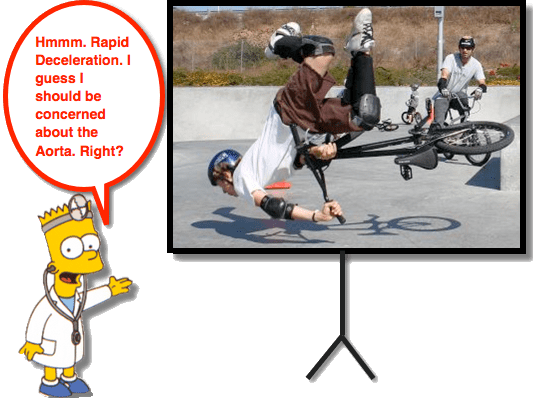Aortic Trauma
Accidental injury (Trauma) leads to more pediatric deaths than ALL OTHER CAUSES COMBINED! Fortunately, unlike in adults, thoracic trauma is less common in kids (only 4-6% of pediatric traumas). Unfortunately, it is the SECOND leading cause of death after blunt trauma (Head Injury is #1). One would think that Aortic Trauma would need to be a major consideration… but, does it?
Kids are Flexible!
- Being flexible can be very helpful … it can also cause problems.
- Cons of Flexibility with respect to Thoracic Trauma:
- Chest wall is very compliant and won’t dissipate impact force – leads to less rib Fx, but more pulmonary contusion.
- Mobile mediastinum can be more influenced by intra-thoracic pressures and potentially compromise Preload more readily.
- Pros of Flexibility with respect to Thoracic Trauma:
- The mediastinum is mobile… not tethered down by a fibrous ligamentous arteriosum… Aorta not as likely to be torn.
Aortic Trauma is Rare
- Fortunately it is Rare: ~0.1% of pediatric trauma registry cases had blunt aortic injury.
- It is good to be young and flexible.
- Unfortunately, 41% of them died!
Imaging
- CXR
- Cannot exclude the diagnosis.
- Look for:
- Apical Cap (blood tracking along left lung apex)
- Widened mediastinum
- Displaced paratracheal stripe to the right
- Displaced left mainstem bronchus inferiorly
- Displaced NG tube toward the right
- Distorted aortic knob
- If you are truly worried about Aortic Trauma, then CT angiogram is the imaging modality of choice.
- Obviously, for such a rare condition, risk of radiation should be weighed.
- Consider the risk factors.
Risk Factors
With such a rare disease, it is difficult to announce true risk factors; however, studies have demonstrated common themes amongst those kids who have had aortic trauma (traumatic aortic injury).
-
Common Themes
- Older Age
- The younger kids are more flexible.
- Teenagers have a more fibrous ligamentous arteriousum… more like adults.
- Multi-Trauma patients with Concomitant Injuries
- Hip Dislocation
- Rib Fractures
- Femur Fractures
- Pelvis Fractures
- Liver/Spleen injuries
- Significant Intracranial injuries.
- High Force
- Older Age
Essentially, these are not the kids that we are debating on whether they need a CT of their Chest. We are looking for extra things to CT (maybe we need to CT the feet).
But, most often theCT of the Chest does not change your management of the Pediatric patient with Thoracic Injury… so don’t go ordering Chest CTs (or Pan CTs) of your pediatric trauma patients reflexively.



[…] Acute Trauma (obviously) […]
[…] attention. We have certainly discussed many trauma topics previously (ex, Abdominal Trauma, Aortic Trauma, Damage Control Resuscitation, Dental Trauma), but the one region of the body that, when injured, […]
[…] Aortic Injuries also reported. […]
[…] special consideration of the differences in anatomy and physiology (ex, Sinus Bradycardia, Aortic Trauma, Back Pain, Traumatic Pneumothorax). What is equally important to remember is that within the […]
[…] http://pedemmorsels.com/aortic-trauma/ […]